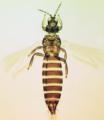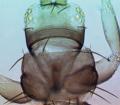Frankliniella schultzei
Recognition data
Distinguishing features
Both sexes fully winged. Body either brown with pronotum tibiae and tarsi paler, or body yellow with faint shadings on tergites; antennal segments III–V yellow at least at base; fore wing pale with dark setae. Head wider than long; three pairs of ocellar setae present, pair III arising close together between anterior margins of hind ocelli, as long as side of ocellar triangle; pair IV as long as distance between hind ocelli. Antennae 8-segmented; segments III–IV with sensorium forked, segment VIII longer than VII. Pronotum with 5 pairs of major setae; anteromarginal setae slightly shorter than anteroangulars, one pair of minor setae present medially between posteromarginal submedian setae. Metanotum with 2 pairs of setae at anterior margin, campaniform sensilla absent. Fore wing with 2 complete rows of veinal setae. Abdominal tergites VI–VIII with paired ctenidia, on VIII anterolateral to spiracle; posteromarginal comb on VIII not developed. Sternites III–VII without discal setae.
Male smaller than female; tergite VIII with a few teeth laterally on posterior margin; sternites III–VII with broadly transverse pore plate.
Variation
F. schultzei is not only variable within and between populations, it also exists as a yellow and a brown form that are more or less distinct. The yellow form is possibly a distinct species, to which the name F. sulphurea applies. However, the two forms are equally widespread around the world, and both commonly occur together in parts of Africa and India. The evidence for recognizing them as distinct species remains weak. Virologists have claimed that the "yellow form" is not a vector, but this appears to be derived from observations on a single population. Certainly, the common form carrying tospoviruses to crops in northeastern Australia is yellow.
Related and similar species
Currently 230 species are listed in the genus Frankliniella, with up to 130 further names placed into synonymy (Nakahara, 1997). This high rate of synonymy has been due to unrecognized variability in size and color of so many species. Scarcely ten of the 160 known species of Frankliniella are considered not native to the Americas, but the origin of F. schultzei remains unclear. It is generally considered to be from South America, although there remains a possibility that it came originally from Africa. The origin of the ocellar setae III between the posterior ocelli is unusual within this genus, being found only in some members of the F. minuta group. Keys to 74 species of Frankliniella recorded from Central America and the Carribean were provided by Mound & Marullo (1996), and to 40 species from Brazil by Cavalleri & Mound (2012).
Taxonomic data
Current valid name
Frankliniella schultzei (Trybom)
Original name and synonyms
- Physopus schultzei Trybom, 1910: 151
- Euthrips gossypii Shiraki, 1912: 56
- Frankliniella sulphurea Schmutz, 1913: 1019
- Frankliniella delicatula Bagnall, 1919: 263
- Frankliniella trybomi Karny, 1920: 36
- Frankliniella persetosa Karny, 1922: 97
- Frankliniella dampfi Priesner, 1923: 64
- Frankliniella tabacicola Karny, 1925: 4
- Frankliniella dampfi interocellaris Karny, 1925: 126
- Frankliniella africana Bagnall, 1926: 100
- Frankliniella anglicana Bagnall, 1926: 281
- Frankliniella aeschyli Girault, 1927: 2
- Parafrankliniella nigripes Girault, 1928: 4
- Frankliniella paucispinosa Moulton, 1933: 122
- Frankliniella kellyana Kelly & Mayne, 1934: 20
- Frankliniella dampfi nana Priesner, 1936: 85
- Frankliniella lycopersici Andrewartha, 1937: 163
- Frankliniella favoniana Priesner, 1938: 30
- Frankliniella pembertoni Moulton, 1940: 247
- Frankliniella clitoriae Moulton, 1940: 248
- Frankliniella schultzei nigra Moulton, 1948: 100
- Frankliniella ipomoeae Moulton, 1948: 95
Family placement
Thripidae, Thripinae
Common names
Tomato thrips
Biological data
Life history
Breeding in flowers
Host plants
Recorded from a very wide range of plant species.
Tospoviruses vectored
TSWV, TCSV, GRSV
Crop damage
Causing damage to various crops worldwide, both through feeding damage and through vectoring tospoviruses.
Distribution data
Area of origin
South America or Africa.
Distribution
Pantropical







